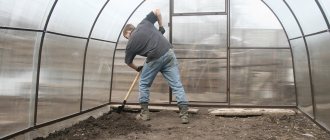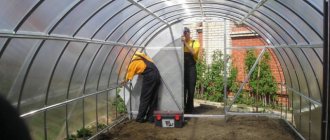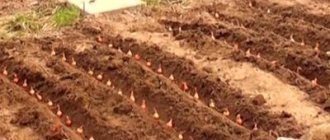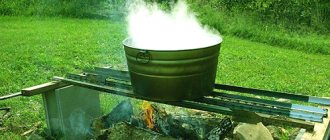Polycarbonate greenhouses are structures that are built for many years of operation and require constant care; the winter months are no exception. Busy gardeners want to know whether to close the greenhouse for the winter or leave it open?
After all, proper care will significantly extend the life of the materials from which it is made, which will allow you to continue growing herbs, vegetables or flowers. It is also important that in winter the soil accumulates a sufficient amount of moisture and undergoes natural disinfection, without the intervention of chemicals.
Priority action plan for pre-winter preparation of the greenhouse
Before frost sets in, you need to choose a few sunny days to carry out some important work in and around the building:
- wash the surface of the greenhouse from inside and outside of accumulated dust and dried dirt;
- remove all existing garbage and restore order on the territory of the building;
- strengthen the greenhouse from the inside to withstand snow pressure;
- insulate the bottom;
- dig up and disinfect the soil.
Perhaps, for some gardeners who have recently acquired a greenhouse, along with the question of whether it is necessary to close a polycarbonate greenhouse in winter, washing the structure will also seem impractical, but performing such work serves two purposes:
- will keep the polycarbonate as transparent as possible for the passage of sunlight;
- If the greenhouse has a streamlined arched design, the clean surface will not prevent the fallen snow from rolling off the roof on its own.
After completing wet cleaning work, there is no need to close the greenhouse doors; access to fresh air will speed up the drying of the room.
Snow from a gable roof may have to be carefully removed with a scraper; If the owners do not live at their dacha in winter, the frame must be well reinforced with supports, otherwise the greenhouse may break during heavy snowfalls.
Preparing and cleaning the greenhouse for winter
At the end of the growing season in the greenhouse, it is necessary to carry out measures to winterize the structure. It is also necessary to prepare the soil in the beds for spring. There is a whole list of works for which the most suitable time is autumn. Greenhouse autumn preparatory work is a contribution to next year's harvest.
Did you know? In the middle of the last century, such a wonderful structure as Ivanov’s vegetarian was invented and designed in the Soviet Union. This is a type of greenhouse, one side of which is a living space. The main highlight of the project is the location of the soil and transparent ceiling at a high angle relative to the sun, which allows the plants to be partially heated even by the winter sun.
Cleaning
All fruit-bearing plants are removed from the soil along with the roots. Plants that still have unripe fruits (peppers, eggplants, tomatoes) are freed from them.
By the way, unripe peppers and tomatoes can be put in a box and transferred to a warm room for ripening; in 10–15 days they will be ripe and suitable for eating. The beds are cleared of mulch and fallen leaves.
The drip irrigation system is dismantled and carefully assembled; in the spring of next year it can be laid out again in the beds. Trim twines and other plant attachments. No matter how good the condition the cords for tying up crops are, they cannot be used next year; they are carriers of viral diseases and insects.
All old garter materials must be taken outside the site, and it is best to burn them. Plant residues are also taken out of the greenhouse, laid out in the sun for several days to dry, and then burned. It is also undesirable to use them for compost, so as not to create a breeding ground for viruses and infections instead of nutritious soil.
All pots, boxes, buckets in which adult plants or young seedlings were grown are cleaned of soil residues, washed, disinfected, then dried and stored until the next growing season.
Soil fertilization
A greenhouse is a structure in which the soil is intensively used, so greenhouse beds must be fertilized twice a year - in spring and autumn. The most optimal is to add organic fertilizers to the soil, such as semi-rotted cattle manure, humus or good compost.
Manure is spread on the beds at the rate of one bucket (10 kg) per m², humus or compost is simply scattered in a layer of 10–15 cm. After the fertilizer is spread on the beds, the soil is dug up and the layer is turned over. Digging depth is equal to the bayonet of a shovel.
The dug up soil is not leveled with a rake, leaving this procedure until spring, since the resulting uneven surface contributes to both freezing of the soil and saturation of the soil with oxygen.
If the gardener has nowhere to get natural fertilizers, and the growing season in the greenhouse has ended early, you can sow green manure (mustard, rapeseed, peas, lupine, beans, alfalfa) in the beds as fertilizer. These crops sprout and grow very quickly.
If they are sown in early or mid-September, by early November the beds will be densely covered with a green plant carpet. Grown green manure is cut off at ground level and embedded in the soil (dropped in).
Some vegetable growers claim that it is not necessary to embed green manure into the soil; it is enough to cut them and water them with one of the biological products (“Vostok EM-1”, “Siyanie-1” or “Baikal EM-1”) at the rate of 3–5 liters of solution per 1 m². To prepare the solution, take 0.5 cups of the biological product and mix it with a bucket of water.
This amount of solution is enough to treat approximately 3 m².
Learn how to treat the soil in a greenhouse against diseases and pests in the fall.
Changing the soil
A very effective, but labor-intensive procedure is the complete replacement of soil in greenhouse beds. To do this, remove the top layer of soil (10–20 cm) and take it out of the greenhouse, after which the surface of the bed is covered to the same height with fresh, fertile chernozem.
Application of fungicides
The least labor-intensive method is to spray the soil with one of the fungicides (Fitosporin-M, Bordeaux mixture, 10% copper sulfate solution) and fumigate the room with sulfur smoke bombs. Fungicides are sprayed over the surface of the soil; it is also necessary to treat all side surfaces and racks of the greenhouse, equipment and tools.
Biological preparations, such as Fitosporin-M, are sprayed only in warm weather, when the temperature inside the building does not fall below +10°C.
Important! After fumigation with a sulfur smoke bomb, fungi and insect pests die in the greenhouse, and mice and moles leave the greenhouse. But not all greenhouses can use sulfur. Sulfur smoke causes metal corrosion, which means they cannot be used in polycarbonate greenhouses with a metal frame.
Fungicides will help cope with bacterial and fungal diseases, but will not have any effect on insects (aphids, nematodes, spider mites), so pests will have to be dealt with in a separate procedure with fumigation with sulfur smoke.
spring-cleaning
Lastly, the internal surfaces of the greenhouse are washed: shelving, lintels, wall coverings and paths. For washing, use brushes and hot soapy water. After wet cleaning is completed, soapy water is washed off from surfaces using a water jet from a hose.
If during the summer months the vegetable grower had to fight diseases or insects in the greenhouse, one autumn general cleaning will not be enough. It is necessary to carry out work to disinfect greenhouse surfaces, otherwise fungal spores, bacteria, viruses, masonry and pest larvae will safely overwinter, and the next season will again be held under the slogan of the struggle for the harvest.
Heat treatment
You can also carry out heat treatment of the top layers of soil. The method is suitable for small backyard greenhouses with an area not exceeding 6–10 square meters. To carry out heat treatment, choose a hot autumn day, when the polycarbonate greenhouse has already been completely cleaned, but not fertilized.
Over the course of several morning hours, the vegetable grower boils water in buckets and pours boiling water onto the beds at the rate of one bucket of boiling water per 1 m². At first and until the end of the procedure, the doors and windows of the building must be tightly closed.
It is advisable to plan so that by 11 am all greenhouse beds will already be watered with hot water, and the room will be clogged. The structure is not opened for the next 24 hours; during this time, all fungal spores and bacteria are destroyed in the steamed soil.
Greenhouse door for the winter: should I close it or not?
If growing vegetables or herbs in winter is not planned, the question of whether to leave the greenhouse open for the winter is not in doubt for some experienced farmers: with the doors closed, freezing out diseases and parasites may not fully occur. Worry about whether it is necessary to open the doors of the greenhouse for the winter rather haunts many novice gardeners. There cannot be a definite answer, since different regions have their own weather conditions: some areas experience severe frosts and heavy snowfalls, while other areas are known for strong winds.
In the south of Russia (Krasnodar Territory and Rostov Region), if the greenhouse is built in an open place or on a hill, leaving the door open unattended can be dangerous: strong winds may damage the structure.
In other cases, when a thaw occurs after severe frosts, condensation forms inside the greenhouses; periodic ventilation is necessary to remove it. Prolonged dampness in cold weather causes the bottom and corners of the walls to turn green and become covered with mold.
Each owner decides for himself whether it is necessary to close the greenhouse for the winter, based on a number of circumstances:
- if the owners live in the country, the structure can be opened for periodic ventilation;
- when there is no one to look after the greenhouse in winter, it is still better to close the door.
By visiting the dacha from time to time, the owners can ventilate the greenhouses during their stay there. Owners of summer cottages who live in the city in winter take into account another important point: homeless animals can live in the buildings. It is worth considering all possible situations when deciding whether to close the greenhouse for the winter.
Arguments for a closed door
Animals will not enter a closed greenhouse.
It is recommended to close greenhouses in the northern regions of the country. In these areas, significant gusts of wind along with winter frost tear off polycarbonate sheets and tear the film into pieces.
Proponents of the closed door argue:
- a closed door protects against heavy snow and gusty winds;
- wild and domestic animals do not penetrate inside;
- there is no way to rob the premises, take out equipment, or break the frame of the beds.
A room closed for a long time without fresh air flows accumulates condensation from internal evaporation, so mold develops in the greenhouse. Stagnant, humid air will ruin the wooden parts of the greenhouse frame; even antiseptic preparations will not help. A green coating appears on polycarbonate, which is difficult to remove from the surface. In this regard, the greenhouse must be properly prepared.
Before closing for the winter, the following activities are carried out:
- sweep away garbage, organic matter, remains of stems and leaves of vegetable crops from the premises;
- check insect nests in corners and crevices and remove them;
- seal all cracks outwards, preventing drafts;
- wipe washable surfaces with a damp cloth;
- elements of the beds (sides, decking) are treated with a soap solution after removing the soil;
- the wood is impregnated with antiseptics;
- the room is disinfected by fuming it with sulfur, spraying it with a solution of bleach;
- steel elements in the structure are painted with oil paints and pentaphthalic enamels.
In winter, the surrounding area is cleared of snow to reduce the absorption of melt water and reduce the influence of soil moisture on the fencing elements. Iced snowdrifts melt slowly, reducing the rate of soil heating after winter with the onset of spring.
How to insulate and equip the bottom of a polycarbonate greenhouse?
If you plan to use the structure only in the spring-summer-autumn season, it would be quite justified to install a greenhouse without a foundation, directly on the ground. In this case, installation is significantly speeded up; over time, the greenhouse can be moved from another place; before the onset of cold weather, such structures are easily dismantled and stored until the new season.
This is a simple and very light and budget option, but does not guarantee the integrity of the structure in case of sharp gusts of wind. How to cover the bottom of the greenhouse? To insulate the bottom from short-term cold snaps, a small layer of earth is thrown around the perimeter from the inside, filling the cracks. On the outside, sheets of flat slate are screwed in or pieces of foam plastic are secured.
In order to make the greenhouse heavier, and still not have to build a permanent foundation, they make a frame from wooden beams, install a frame on them and secure them with T-shaped fasteners. The site for installing the greenhouse is leveled, eliminating holes and hummocks so that the structure fits more tightly to the ground. A small mound of earth is poured inside and outside around the greenhouse so that there is less cold from below.
Need I remind you that the bottom of the greenhouse needs to be insulated from moisture, dust, dirt particles, and earthworms getting inside the polycarbonate. The cells can be closed with a plastic profile, which can be purchased at the same store as polycarbonate.
Before deciding whether to close a polycarbonate greenhouse for the winter, you need to carefully inspect the door unit to make sure that everything is in good working order and that gusts of wind will not blow the doors off their hinges. Polycarbonate is a very durable material, but it is better to insure against unforeseen weather conditions.
Dangers of opening a greenhouse
Some experienced greenhouse growers believe that the doors of a polycarbonate greenhouse, open throughout the winter, are absolutely unacceptable.
Did you know? One of the types of greenhouse structures is a greenhouse. The main difference between a greenhouse and a greenhouse is the low distance from the ground to the ceiling and the thick cushion of horse manure placed under the soil layer, which heats the structure from below.
- Arguments against opening the doorway:
- Winter storms or strong winds can shake or even topple the structure if the wind blows directly into the doorway.
- During snow storms, excessive amounts of snow can get inside the greenhouse, which will delay the warming of the soil for several weeks in the spring.
A greenhouse is a shelter for growing garden crops. A vegetable grower who has such a structure on his plot will receive the first harvest of pimply green cucumbers, red tomatoes or fragrant greens before other gardeners.
Pros and cons of an open greenhouse
Why is it better to leave the greenhouse open in winter, you ask? As supporters of this method note, the soil in an open greenhouse rests and is naturally disinfected.
Maximum proximity to natural conditions has a beneficial effect on the soil cover. The snow masses that fall inside the structure moisturize the soil well. During severe frosts, the soil in the greenhouse freezes, killing bacteria, microbes and pathogens of various fungal and viral diseases. During the thaw period, the soil warms up and is saturated with useful microelements and vitamins.
With the arrival of spring warmth, the soil has rested, been renewed and is ready for planting new fruit and vegetable crops. On such soil you can expect high yields.
A greenhouse that is open for the winter also has some disadvantages. First of all, it is necessary to talk about possible damage to the structure. Most often, such troubles occur in regions characterized by strong winds and hurricanes. To avoid damage to the frame or skin of the greenhouse, you should prepare for wintering. First you need to remove all plant debris and thoroughly clean the internal surface, then you can begin to strengthen the opening elements.
Some companies engaged in the production and sale of ready-made greenhouse structures offer gardeners complexes that correspond to the characteristics of a particular region.
Whether you open the greenhouse or not is up to you. But be prepared in the spring to meet new “tenants” who have settled in a place protected from wind and snow. We are talking about stray cats, dogs and other animals.
Global processing
If the greenhouse is large, gas disinfection can be carried out. For this purpose, sulfur-containing fungicides are used. They look like smoke bombs that release toxic fumes. Sulfuric anhydride fills the greenhouse room, making its way into even the most inaccessible places.
The gas combines with drops of moisture settled in the ground and on structural elements. This facilitates total disinfection of all surfaces. This remedy will even help get rid of spider mites that are resistant to other means. All pathogenic microflora will be destroyed, as well as larger parasites. The procedure is carried out according to the following scheme:
- The premises are treated no later than mid-October. The temperature should not fall below +10°C.
- Thorough cleaning and digging of the soil is carried out.
- The room is sealed. All cracks must be caulked and holes, if any, must be sealed. Rubber seals need to be replaced on windows and doors.
- Metal frame elements that are not coated with paint are treated with grease. If there are scratches or chips on the enamel surfaces, they are additionally painted.
- The amount of the drug is calculated in accordance with the square footage of the greenhouse.
- The person carrying out the treatment changes into protective clothing.
- The soil and structural elements inside the greenhouse are sprayed with a spray bottle.
- Place the checker vertically on a heat-resistant base and light the wick.
- A person must leave the greenhouse as soon as the wick smoldering process begins. The door closes tightly.
- After 3 days, the greenhouse door is opened, all the vents and windows are thrown wide open. Ventilation takes a long time. The smell of sulfur should completely dissipate.
Soil disinfection
The lower layers of the greenhouse soil also need additional treatment. Traces of infections and weed rhizomes may remain here. To perform disinfection, the following methods are used:
- You need to dig up the soil with a bayonet shovel, and then loosen it thoroughly. This will help the soil freeze deep enough to keep any pests out. In the process of digging up the soil, plant roots and insect larvae are removed. If you have enough time, you can re-sow the substrate. This will allow you to obtain high quality soil.
- Another way to get rid of pathogens and parasites is to replace the soil in the greenhouse. A special substrate is purchased, which contains nutritional components. You need to cover the healthy soil with a layer of about 25 cm. It is loosened and left until spring.
- It is possible to qualitatively clean the soil from unwanted microorganisms, weeds and insects using heat treatment. To do this, the soil is heated by pouring boiling water over it. Then the surface is covered with film. But after this the substrate becomes “dead”. In order for garden crops to develop in such land, a lot of fertilizers need to be applied. The soil is treated with special preparations, for example, Azotophyte, Biodestructor or similar compounds.
Experienced gardeners advise not to freeze the soil in order to disinfect it. Because of this, you will have to plant seeds and seedlings in the greenhouse later. It is better to thoroughly disinfect the soil in the fall, and cover it with a layer of snow in winter. This way the ground will not be able to freeze too much. In the spring it will warm up faster, allowing you to open the gardening season earlier.
Cleaning a greenhouse in the fall
Preparing for winter in a greenhouse begins with general cleaning. During the season, the room where vegetables, fruits, herbs, and other plants are grown becomes polluted. Remains of tops and plant parts accumulate on the soil. Microorganisms develop in the soil, and insects may remain for the winter. Because of this, pathogens, fungal spores and other infections may be present in the air.
Various contaminants accumulate on the frame materials, walls and soil of the greenhouse. If quality harvesting is not carried out in a timely manner, future harvests may suffer from pathogenic flora. Proper cleaning of all surfaces and interior space will also extend the life of the greenhouse.
Preparation of the greenhouse begins with removing everything unnecessary from the premises. This stage should not be neglected, as subsequent procedures will be less effective. All items must be removed from the premises. You cannot store equipment, fertilizers, seedlings, etc. here. There should be bare soil without tops, dead wood and other traces of vegetation.
You will also have to take out plant supports and pegs that need to be cleaned and stored outside the greenhouse. All garbage, weeds, tops are removed. They are burned in a special oven.
The top layer of greenhouse soil is removed. Traces of infections and insects may remain here. It can be poured into a specially designated place in the garden without scattering the soil much. It is dug up and left for the winter. The soil will freeze, become disinfected and become suitable for further cultivation.
If perennial crops grow in a greenhouse, they do not need to be uprooted. Only diseased plants are removed. Old leaves and diseased shoots must be cut off from other bushes.











